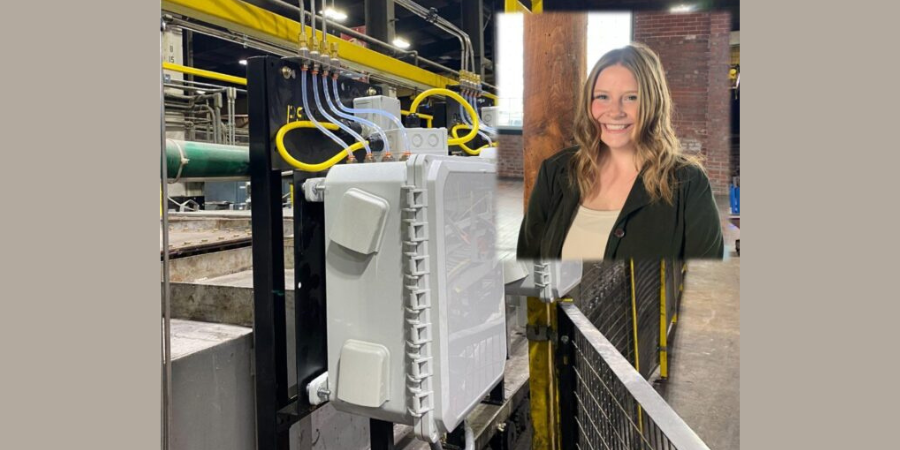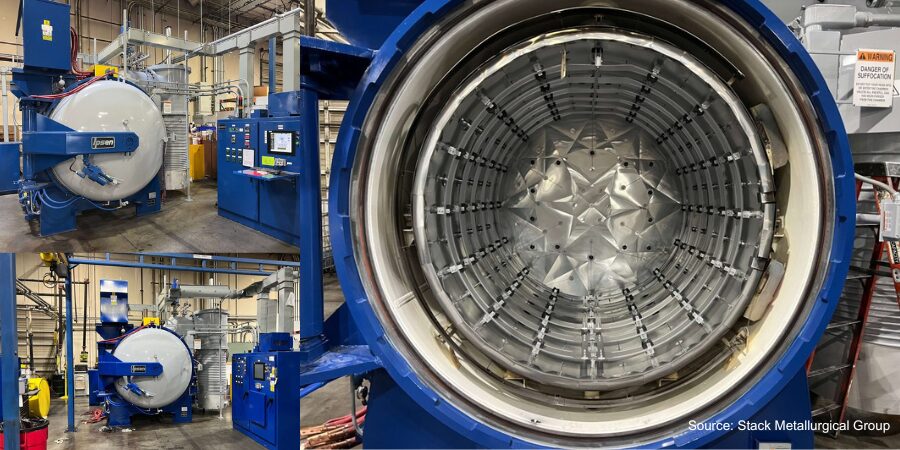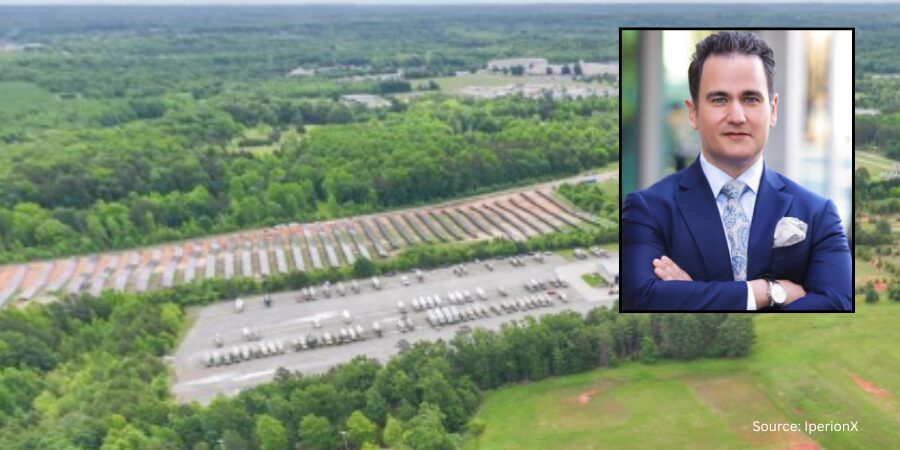![]() With energy costs soaring and environmental commitments expanding across the industry, is it enough to just tune your industrial combustion burners, or can IIoT devices provide greater insight to achieve burner energy efficiency?
With energy costs soaring and environmental commitments expanding across the industry, is it enough to just tune your industrial combustion burners, or can IIoT devices provide greater insight to achieve burner energy efficiency?
This Technical Tuesday article, written by Taylor Smith, technical sales and marketing specialist, PSNERGY, LLC, was first published in Heat Treat Today's February 2023 Air & Atmosphere Furnace Systems print edition.
Introduction

Specialist of Technical Sales and Marketing at PSNERGY
Source: PSNERGY
Industrial furnaces are inherently inefficient and constantly degrading due to high operating temperatures. In most cases, less than 50% of the energy generated through combustion goes to heating the load, while most energy is lost through the exhaust stack or is used to heat the atmosphere, fixtures, and walls of the furnace. An improperly tuned furnace loses 10-30% efficiency on top of the energy losses previously mentioned. This is why keeping industrial furnace combustion systems in tune is critical to performance. This was recently highlighted in John Clarke’s featured article, “How To Make $17,792.00 in a Couple of Hours.”
Continuous Monitoring Is Key

Built on years of experience and field data, combustion engineers at PSNERGY know that only tuning combustion systems annually, or semi-annually, is a good start, but it is not enough. Customer case studies led the team to recognize the importance of frequent combustion monitoring to achieve optimal performance, and ultimately drove the design of their proprietary IIoT monitoring system: Combustion Monitoring and Alerting (CMA).
To get the most BTUs to the load per unit of natural gas purchased, tuning must be combined with continuous combustion monitoring. Tuning without continuously monitoring combustion increases the risk of losing energy to the load, decreasing efficiency, and creating excessive carbon emissions.
Case Studies: Data-Driven Furnace Efficiency
The following case studies represent two examples of data collected throughout the country on furnaces of all sizes and configurations. One thing remains consistent: simply checking combustion once or twice per year does not ensure optimal furnace performance.
These figures show before and after measurements taken on the same forty-four burner radiant tube roller hearth furnace, six months apart. The red points on the graphs represent excess oxygen in each burner’s exhaust when the team arrived on site, while the blue points represent excess oxygen in each burner’s exhaust after tuning the furnace. A significant variance in combustion performance can be observed in the six months between tunings, which means a large portion of the natural gas purchased is being wasted out the stack and creating carbon emissions.
To ensure maximum energy is being applied to the load for every BTU burned, combustion should be tuned to the ratio of 11.5:1. This 11.5:1 ratio of air to gas results in an ideal excess oxygen measurement of 3%. When PSNERGY engineers perform combustion tuning on an industrial furnace, they set the excess oxygen at the burner between 2.8% and 3.2%. This optimal range is marked by the green dashed lines on the graphs.
You may be questioning, “Does too little or too much excess oxygen really affect combustion performance?” Yes! Burners operating above 4% or below 1.5% are considered outside of the control limit range, marked by the red dashed lines on the graphs. With less than 1.5% excess oxygen at the burner, furnaces produce carbon monoxide and soot, which can clog burners, making them even more inefficient. These carbon emissions can also create an unsafe work environment for plant employees. When operating at 5% excess oxygen, 8% of energy to the load is lost. When operating at 7% excess oxygen, 21% of energy to the load is lost. Imagine buying the same amount of natural gas and only getting 79% of the energy!
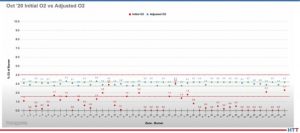
Source: PSNERGY
A few things to notice on these graphs: burners are rarely, if ever, found in the ideal performance zone after six months. There is no way to know when each burner drifted out, because continuous monitoring was not yet implemented. Therefore, this drift in combustion performance, which significantly decreases furnace efficiency, could have happened anytime during the six month period between combustion tunings. Tunings may be scheduled, but combustion does not operate on a fixed schedule. You cannot know when the burners drift out of tune without monitoring. Another point to note is that the burners do not always move in the same direction as they go out of tune. In Figure 1, thirty one out of the forty four burners were burning under 1.5% excess oxygen, which means they were burning rich and creating carbon emissions and soot. The PSNERGY service team tuned all of those burners back into the optimal performance range. As you can see in Figure 2 data, taken six months later, out of the same forty four burners, seven burners were burning rich, while thirty one of the burners were operating lean with over 4% excess oxygen, which significantly decreases the amount of energy to the load. These figures demonstrate why it is crucial to continuously monitor and tune your combustion system as needed based on the data, not the calendar.
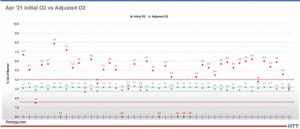
Source: PRNERGY
Combustion Monitoring and Alerting (CMA)
Circling back to our initial question of, “Can IIoT devices provide greater insight to achieve burner energy efficiency?” the data presented here answers with a resounding YES! In fact, various companies across steel, aluminum, and heat treating industries have already successfully implemented this solution.
Not only does continuous monitoring help achieve burner efficiency, but it also helps bridge the gap in combustion knowledge and manufacturing by making combustion performance easy to see and maintain. With manufacturing leaders facing fourteen-year high natural gas prices and a generational gap in manufacturing expertise, systems like CMA are proving to be crucial to business success. Delivering 10-20% improvement in furnace efficiency, less waste, reduced carbon emissions, and ensured quality, takes your furnaces from being a necessary expense to a strategic asset.
Now the question is: Are you performing combustion maintenance on a fixed schedule or are you trusting real time data?
About the Author: Taylor Smith is a specialist of Technical Sales and Marketing at PSNERGY, located in Erie, Pennsylvania. Her tenacity and competitiveness as a Division I athlete have helped her quickly gain knowledge and hands-on experience in the heat treating industry. Taylor has a deep passion for manufacturing and works hard to build the next generation of leaders, serving on the board of directors for Women in Manufacturing WPA. For more information: contact Taylor at tsmith@psnergy.com
 Find heat treating products and services when you search on Heat Treat Buyers Guide.com
Find heat treating products and services when you search on Heat Treat Buyers Guide.com




